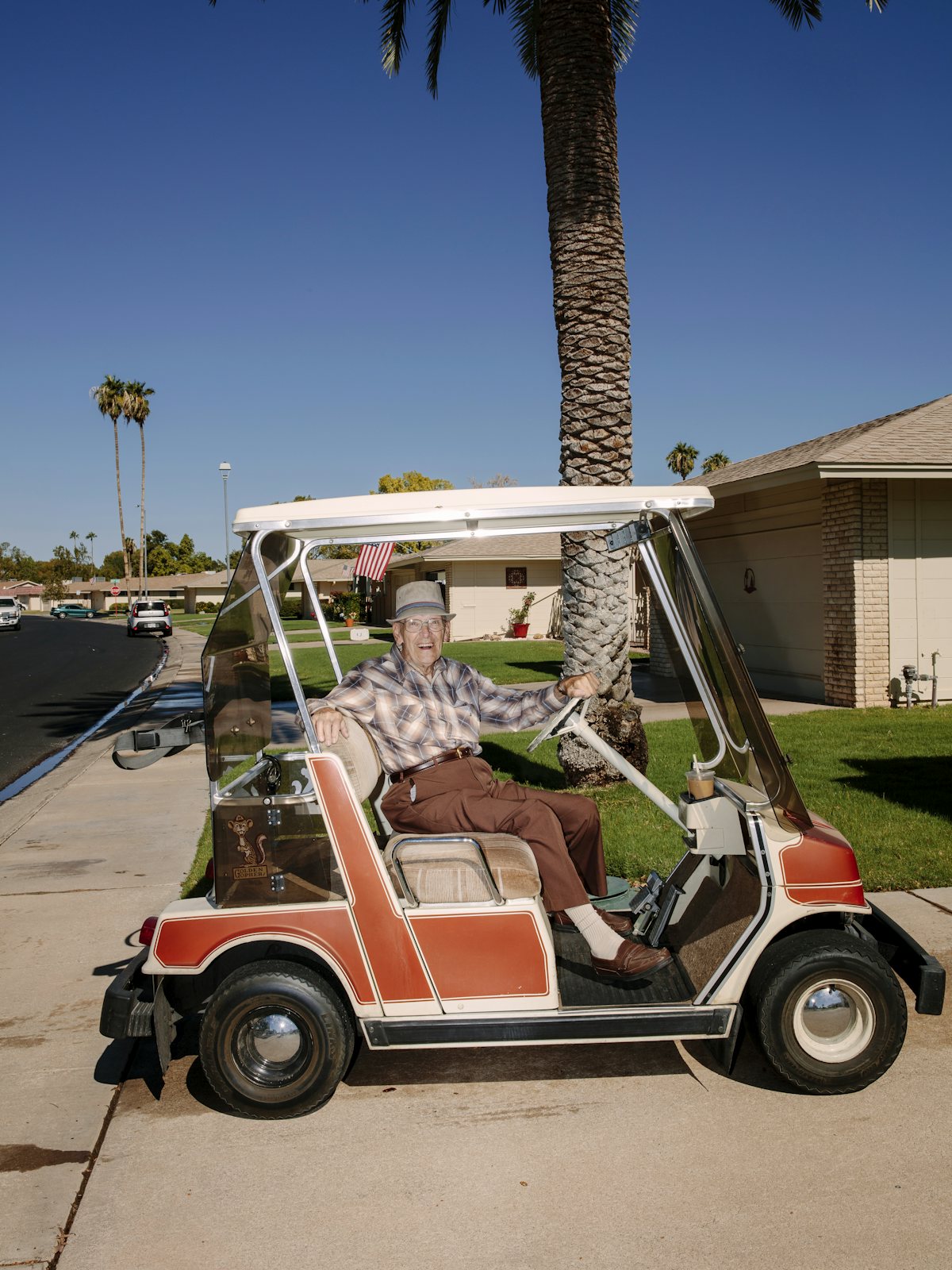Old age has become a strangely tangled subject in the United States. Even after Joe Biden delivered one of the worst debate performances in recent history, his defenders routinely denounced his critics as ageist. The same thing happened with Senator Dianne Feinstein: Three years after The New Yorker reported that the then 87-year-old’s cognitive decline was an open secret and source of concern on the Hill, public debate over whether she should resign was still dogged by accusations of age discrimination. And when Justice Ruth Bader Ginsburg actually died in office at age 87, paving the way for a conservative court that is steadily unraveling her legacy as well as the hopes, health, and security of millions of Americans, both the American Society on Aging and the AARP portrayed this staggering own goal as a triumph over ageism.
Ageism is real, but it’s a hard accusation to parse when the individuals in question, holding the fate of millions in their hands, are demonstrably in ill health. And it’s even more discordant in a country where many would love to look forward to the kind of cushy retirement that these elites seem to fear.

How do we reconcile American gerontocracy—the average age in the Senate, after all, is 64, and the elderly poverty rate is below average, while the child poverty rate is above it—with the grim reality facing millions of elderly people in the United States? Many fear they lack the funds to weather old age with dignity; they worry about health and long-term care, and what they will do if they lose the ability to drive in a country built first and foremost around cars. Scratch an apparent paradox in U.S. society, and you will usually find simple inequality. But in the matter of old age, inequality has driven our political discourse to almost unparalleled levels of incoherence.
Golden Years: How Americans Invented and Reinvented Old Age, by intellectual historian James Chappel, is a story about how the very concept of “retirement” came into being. But it’s also a story about how we got to the current moment: when many people face precarious and delayed retirements fraught with grim choices about long-term care, while others with lavishly funded retirements and abundant options find the very idea of retirement offensive. This isn’t just a cultural problem or individual denial of our own decline, Chappel insists. This is a crisis created by policy, exacerbated by a great deal of political dishonesty about where the actual crisis is located.
There are many myths about why aging is particularly fraught in this country, each of which Chappel dismantles in turn. The first to fall is the prelapsarian vision of a once-harmonious aging process that industrialization disrupted: that “once upon a time” intergenerational homes were the norm, and those who made it to old age were cared for with respect by family.
But intergenerational households were actually a minority in the United States in the nineteenth century. Farmers, Chappel acknowledges, typically had a grown child or two “stick around in the hope of inheritance.” But that means many older people—who were still doing some farm labor—had a child living with them, not that most children had a parent living with them. Given the high birth rates of the era, there were “fewer older relatives to go around, and more grown children to choose from.” And families today do more care for their elders than families used to, he writes, because modern medicine has enabled people to live longer with age-related disability than they used to.
The instinct to tie security in old age to work—thus duplicating significant inequalities in the labor market—started early. Prior to the New Deal, organizations seeking to expand state pensions beyond Civil War veterans typically made arguments about moral desert, based on years of labor. But their successes were mostly limited to private pension plans and public pensions for state employees. It wasn’t until the introduction of Social Security in 1935 that expectations of old age truly changed. “Social Security,” Chappel writes, “created, for the first time, a legitimate expectation that Americans could look forward to ten or fifteen years of comfortable life on the far side of the labor market. It created, in other words, a broadly shared idea of what old age could be.”
But it came about in a backward way. Political support for what was initially called old-age insurance materialized over the worry that the elderly were “putting strain on their children’s families” during the Great Depression. The goal was to eliminate “dependence”—the burden the elderly represented, not the poverty they experienced. The policy now known as Social Security was instead “based on the premise that gainfully employed older Americans, in order to maintain independence from their children and from charity, would need variable amounts of resources depending on the income and lifestyle they were used to.”
That’s how we got the model in which people contribute with a portion of their paycheck, and later receive benefits in proportion to those contributions. It was a system, the book stresses, that would “reproduce, rather than challenge, the hierarchies of race and gender that governed the labor market itself.” Those who earned a low wage during their working years would have a leaner retirement than people who had held high-income positions. In addition to initially cutting out agricultural workers and domestic workers—many of whom were Black—this model of old-age insurance ignored those who worked without compensation, like women laboring in their own homes.
There were compelling alternative paths that could have been taken, Chappel notes—both fairer and more hedonic. The Townsend movement, named for Californian physician Francis Townsend, wanted to institute a national 2 percent sales tax and use it to give $200 a month (nearly $5,000 in today’s cash) to anyone over the age of 60, on the condition that they spend it all within 30 days—no lengthy debate about who deserved what, no hand-wringing about worthwhile pursuits, just pure YOLO consumer power to zap the country out of the Great Depression and help it into a machine age where fewer workers would be needed. The Ex-Slave Mutual Relief, Bounty and Pension Association, which campaigned for pensions for formerly enslaved people who had been emancipated into poverty and disability, would likewise “have used old-age policy to attack and redress some of the most insidious injustices of American society.”

Reformers continued to imagine radically better versions of Social Security once it was established—each one a gut punch to the reader who knows how this story ends. In the late 1960s, for example, sociologist Jacquelyne Jackson proposed different age thresholds based on racial discrepancies in life expectancy: Making everyone reach 65 before drawing benefits, Chappel explains, meant that white people, who had on average longer life expectancies, would benefit more than Black people. By 1980, “the median white man would enjoy its benefits for nine years, and the median Black man for only two.”
All of these paths to a more equitable future were rejected. And yet Social Security ultimately worked, even for the people it treated unfairly, Chappel argues, as it reduced rates of elder poverty and specifically of Black elder poverty. It continues to work far better than most people—particularly those trumpeting its ever-incipient demise—give it credit for.
Within a decade or two, New Deal policies gave rise to fresh imaginings of old age as a kind of Disneyland with lots of pottery classes. With that faint hint of the manic the 1950s and ’60s did so well, a new industry and discourse exploded around how newly minted “senior citizens” should spend their time and stave off decline. Medicare’s passage in 1965 helped address escalating health care expenses—yet another policy, in Chappel’s telling, adopted due to politicians’ skepticism of intergenerational households, although this time the concern was that grandparents returned to dependency for short-term health needs would mar the image of the perfect anti-communist nuclear family.
But almost from the moment that retirement as a universal life stage became imaginable, it came under threat. Just as policymakers were gearing up to tackle the inequities in Social Security, Milton Friedman showed up suggesting the best way to do this was to get rid of it, and replace it with a poverty program instead. Given that, from a political perspective, “Social Security works precisely because it latches help for the poor to a broad middle-class benefit,” Chappel finds it hard to take Friedman’s and his allies’ purported goal of targeted poverty reduction at face value: The replacement program would have been “ripe for budget cuts at the earliest opportunity.”
Neoliberalism is one of the villains in this book. With increasing vehemence throughout the 1970s, its prophets pushed the idea of a “crisis” in Social Security, portraying the program as a wasteful and inefficient “Ponzi scheme” that could implode at any minute. At just this time, employers were also growing wary of the cost of pension plans. The result was a huge move toward private retirement savings: People worried about Social Security were instructed to invest in the individual retirement accounts (IRA) and 401(k) plans that became available via new tax policy in the 1970s. But 1980s culture takes some heat as well in Chappel’s narrative. New and more pernicious ideals of independence, he notes, provided moral cover as the state and employers shifted the responsibility for security in old age away from society and onto individuals.
Depictions of older people in pop culture reflected the individualist mood. The sitcom The Golden Girls pushed back against stereotypes of “old ladies,” by depicting four older women leading active, independent, and even sexual lives. It was a vision of empowerment, in sync with the American Association of Retired Persons’ fight against ageism in this era, which focused on lobbying against mandatory retirement and age discrimination in the workplace. Yet Golden Girls, Chappel argues, also spoke to a harsher emerging reality: that the financial lives of older people felt precarious. Was the phenomenon of more older women going back to work, or engaging in self-care via careful nutrition and exercise, desirable—a blow against ageism—or merely a necessity as good pensions grew rarer and medical costs rose? Is the ideal of “independence” liberating, or an insidious form of social control? In Chappel’s story, there aren’t easy answers to these questions. Ageism was and is a real problem, he acknowledges. But focusing on ageism to the exclusion of other policy debates relevant to old people, as the AARP did in this era, reinforced the idea that the goal should be to remain employed and independent as long as possible.
The AARP, in this story, was to old age what the Obama-era “girl boss” movement was to feminism: correct in identifying inequality, but deeply and narcissistically misguided in thinking this could be fixed by, say, sufficient numbers of the disadvantaged group in question excelling in the workplace. It’s tempting to see the organization’s name change as revealing: Once the “American Association of Retired Persons,” the interest group in 1999 became just “AARP.” Maybe dropping the “retired” partly reflected the organization’s long-standing interest in attracting members from the sub-60 crowd, or the reality that “both Social Security and pensions were on the ropes and mandatory retirement was illegal.” Or maybe, somewhere between the 1950s and the year 2000, retirement stopped smelling of ceramics to most people and started smelling of irrelevance.
Reading Chappel’s account of the interplay between policy and culture, it’s perhaps a little easier to understand the apparent tension between people persisting in jobs far past the point of reason (Biden, for example), and the misery of some older people who don’t have that choice to begin with. It’s easier to understand how we got to the odd patchwork of social programs we now have. But that doesn’t fully elucidate the raging dysfunction that is old-age politics in the United States.
Histories are the stories of change—they’re not always disciplinarily inclined to identify the constants, let alone emphasize them. And yet constants are a powerful form of cultural conditioning, and surely at work when it comes to mass unwillingness to think clearly, creatively, and compassionately about old age.
The uncomfortable truth is this: We do treat retired people as irrelevant. And as another historian, Samuel Moyn, recently observed while contemplating gerontocratic tendencies in this country: “In a society in which elderly people are treated as irrelevant and are subject to neglect, those of them holding authority have no incentive to hand over the reins.” Our cultural denial of old age is surely part of why it’s so difficult to pass policies that would improve the material conditions for old age. And our society’s insistence on individualism makes it very hard to shift cultural norms that make paid work essential not only to receiving benefits, but also to defining one’s identity.
A recurring theme, for example, in Chappel’s story is of seniors not wanting to retire. People being pressured to retire solely because of age is a problem, and ageism is a good label for it (although it’s worth noting that age-specific restrictions are far more common for young people than old ones, and minimum ages for voting, drinking alcohol, or hiring a rental car, say, mostly hold up in court). People not wanting to retire, however, because they cannot imagine who they are or how they can justify their existence to others without gainful employment? That’s just as big of a problem.
There are some signs of change on this front, although from wildly different corners: on the collective action side, young socialists’ and climate activists’ embrace of policies like the four-day workweek; and on the individual side, the surprising traction in recent years of the Financial Independence, Retire Early, or FIRE, movement. This subculture, which once seemed populated exclusively by thirtysomething techbros eating ramen in a shack to achieve a 70 percent savings rate and retire by 40, has now broadened to include more than a few women, people of color, single parents, teachers, and others outside the stereotypical demographic. For these people, cutting consumption drastically is worth it if they can ditch their boss a decade or more ahead of schedule and fill the time with family, friends, and passion projects instead. These surprising moments of resonance between the Green New Deal, the TradCath homesteaders, and the FIRE movement make you wonder whether Gen Xers and millennials across the political spectrum might be ready to rethink work-as-identity, as well as the consumerism that keeps the affluent wedded to work-as-identity.
The real problem with aging in the United States, for Chappel, isn’t ageism, but ableism. “A great deal of the anxiety about retirement income,” he writes, “is really an anxiety about retirement health: what will happen to me and my family if I need long-term care?” Medicare doesn’t address this: You have to run through your savings first and then get funding from Medicaid instead. Twentieth-century old-age pop culture didn’t address this: “the discussion of aging in the 1980s was about individualism and entrepreneurialism,” and many old people feared being lumped in with the “old-old,” i.e., the disabled. Not retiring isn’t an option either: You can only work as long as you are able.
Again, activists have presented appealing alternatives: turning senior centers into hubs complete with “meal delivery services, home health aides, and even end-of-life care.” But instead of facilitating the large-scale adoption of these models and recruiting “well-trained and well-paid” people to staff them, Chappel writes, policymakers leveraged “familial affection to solve a policy problem,” telling caregivers that “long-term care was a natural obligation of grown children, and one that their ancestors had done without complaint”—an ahistorical lie that has caused real damage. With a dearth of options, families that reach a breaking point have little choice but to put a parent in a nursing home they can’t really afford with staff who aren’t well paid. They often feel hideous about it—a problem exacerbated by the messaging around filial duty.
The answer to our current mess, Chappel argues, is inclusion: an old-age movement that includes the disabled rather than simply leaving people to hope they won’t become disabled; health care policies with fewer seams—maybe Medicare for All, and maybe with long-term care provisions; Social Security reform, not cuts; transportation that doesn’t depend on cars.
These are all good ideas. But there is another, related way out of this crisis: to sever the link in this country between paid work and the provision of a basic social safety net. Other countries have already done this, particularly via publicly funded health care. Yet America’s work fixation lies at the center of this entire narrative—an origin story for Social Security’s inequities and a fig leaf for attempts at privatization. Workism is closely tied to ableism, and is often deployed in political contexts for deeply racist purposes. It overlooks and stigmatizes unpaid caregiving, often performed by women, and drives the “welfare queen” stereotype, used by politicians to discredit the provision of public assistance to impoverished Black people. There’s considerable evidence that work requirements for food stamps exacerbate poverty. And the idea that only people who work really matter is exacerbating the cultural forces that drive many seniors to despair and cause elite seniors to cling to power.
Plenty of people are already starting to question the primacy of the career in defining identity: a form of identity that has always left a lot of people out, and that, in addition to subtly disparaging certain types of work, undervalues unpaid ways of spending our time that can be more fulfilling than we grow up hearing a career should be. Think hobbies, think childcare, think spending time with friends and family, think sleep. We don’t actually need to lead a national charge to unseat the primacy of work in the American mind, which has led so many affluent people to fear the emotional side of retirement even as the less-affluent fear the financial side. Lots of people are already trying to do that. But it would be easier for them to pursue those alternative visions of a worthwhile and balanced life if we stopped making access to good, cheap health insurance, 401(k)s, and Social Security dependent on full-time jobs at large companies.
Chappel closes his book with a moving image of senior citizens sitting on a beach guarding turtle eggs: “Sentinels watching over the precious life teeming underground, and watching, too, the children laughing.” It’s a role similar to one that Bill McKibben’s Third Act movement for climate action has imagined: seniors using their experience and influence to look out for the planet and for the next generation. It’s a powerful vision, but it only works at scale if we manage to separate meaning from market value—both when it comes to retirement, and when it comes to the worthy ways people might spend that retirement.




